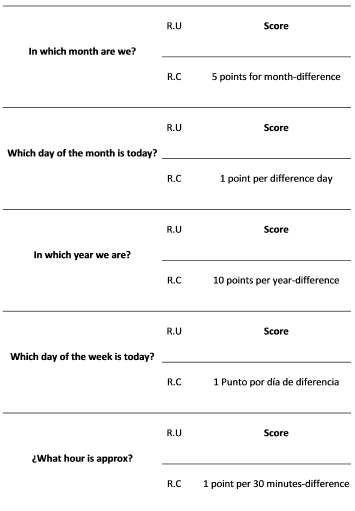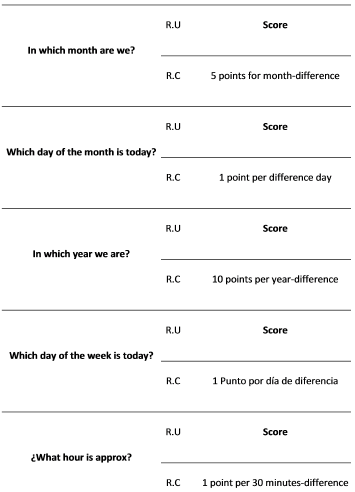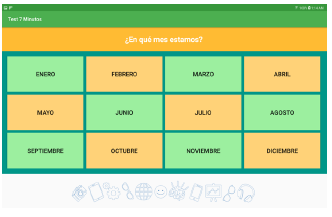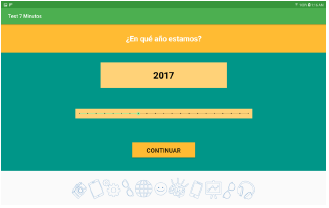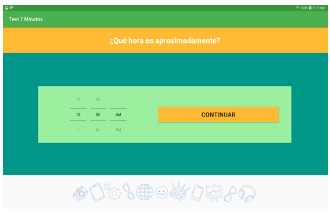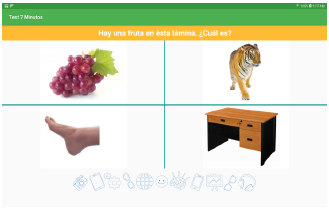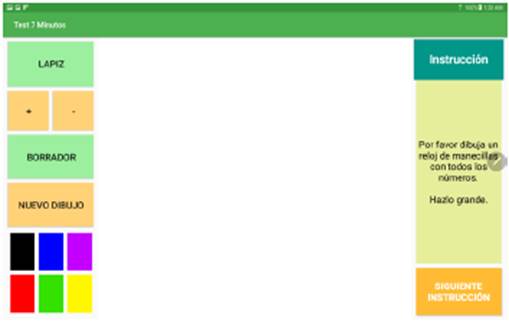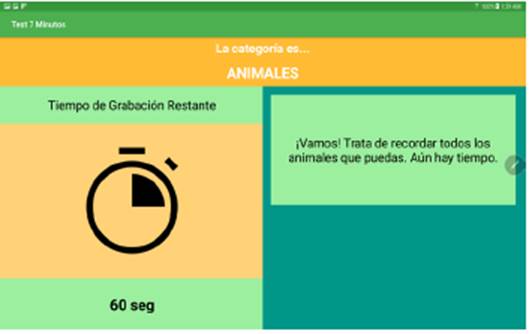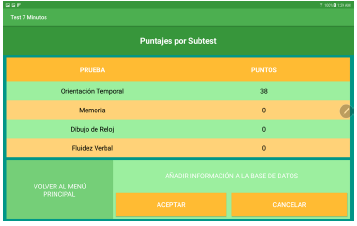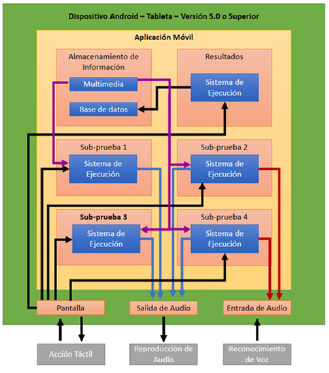1 INTRODUCTION
Alzheimer's disease AD is a neurodegenerative disorder that manages to generate cognitive variations in the person who suffers it. AD has taken a significant position in research because of its high level of complexity in treatment. This has made that much of the research is based on the treatment of the disease but not on the cure. In recent years, interest in the construct of mild cognitive impairment (DCI) has increased in order to identify early disease associated with dementia [1]. Alzheimer's disease (AD) is characterized by cognitive and behavioral depreciation, which takes place commonly in adult ages, especially in old age, being one of the main factors not modifiable [2].
Already knowing that the AD generates the neuronal deterioration, the memory of the person begins to be affected. That is why there must be a prior knowledge regarding the memory of the human being. The authors have carried out some preliminary research on this, as it can be seen in [3]. Since the current research that is to be carried out is based on episodic memory, certain knowledge is presented that are vital for the optimal future development of the research.
2 THEORETICAL BACKGROUND
2.1 Episodic memory
Episodic memory is the neurocognitive system that allows to perform the mental process of retrieval of the information stored after a time, where the information has an interrelated construct of subsystems. This system of memory encompasses a particular memory and links it to episodes or lived experiences, which are dependent on the context and its spatiotemporal and personal association [1]. Similarly, episodic memory is strongly influenced by the emotional state at the time of the event [4].
For the clinical study of episodic memory, it is important to know the behavior in the neural networks and lobes in which this mental process is carried out. Several investigations suggest that episodic memory depends on the frontal lobe, temporal lobe and hippocampus [1], [5], [6], but specifically its behavior is supported by the areas of prefrontal cortex association, temporal lobe area components and areas parahippocampal cortex, which are reciprocally connected to the hippocampus [7], [8].
To detail the behavior of each of the above mentioned areas, the parahippocampal cortex is the one that allows the processing of the spatial context, therefore, knowing lesions in this area will demonstrate a deficiency and deterioration of memory for the context in which presents an object [7]; the hippocampus is responsible for performing the process of recognition of the context in which specific stimuli were experienced [9], thus helping to acquire, consolidate and retrieve information. In general, hippocampal neurons are responsible for encoding a large number of characteristics of the events and places where they occur. Although the frontal lobe is one of the most complex systems to analyze, it is responsible for performing executive and selective functions such as decision making, planning, organization, problem solving, among others [10]. In general, the temporal lobe performs several functions such as facial recognition, memorizing geometric figures, graphs, melodies or verbal characters [11], [12], consequently, as AD (Alzheimer Disease)affects the integrity of the temporal lobes, it is clear to recognize that there is a loss of memory, both episodic and semantic [13].
2.2 Measurements tests for episodic measurement
The evaluation of the episodic memory has been an important point to know the cognitive deterioration in people with AD [1], [2], therefore, a great variety of investigations have focused their studies in the application of specific tests for the evaluation of the memory episodic visual and verbal [4]. Tests such as FCSRT [5], RBANS [4], MAT [6], Wechsler Memory Scale [7] and CVLT [8] are those that have been used frequently for their performance. Compared with the previous tests, which can be very long, there are other tests, such as the 7 Minutes Screen or Test of the Seven Minutes, which are made up of sub-tests that allow to evaluate also the long-term memory, analyzing areas involved in EEG, such as tempo-spatial orientation, memory, verbal fluency and visuoconstructive skills [9].
2.2.1 FCSRT
Free and Cued Selective Reminding Test (FCSRT) is a test that has been recommended by the International Working Group (IWG) as a reliable tool for the evaluation of episodic memory failure [1]. This test has been applied in two different ways that are visual and verbal [5], and further divided into two phases. The study phase is the first to be executed, where we proceed to show 16 items to the participant, which have the characteristic of being semantically different, where these are divided into 4 groups. Each group is presented on a card where each quadrant shows the item to be memorized. The procedure is based on the presentation of the first card, where the participant is asked to memorize the 4 items shown, naming each of the items aloud. Then you will be asked by means of signals or clues what were the memorized items. After completing this procedure, the following card will be continued, repeating the process until all 4 cards have been shown. Following the test phase, three trials are carried out, where there is a lapse of time between each to avoid short-term memory recall. This time is a cognitive task where the participant is asked to count down for a lapse of 20 seconds [10], of course depending on who performs the test, the time can vary up to 30 minutes waiting [1], [4]. In each essay, the participant has up to 2 minutes to be able to freely recall the items in the study stage, otherwise, items or categories of items will be used to facilitate the information retrieval process, but if at the end, it does not remember the item, the investigator must show the item. If the third test is running, the item not remembered should not be fed back.
As far as data collection is concerned, a score scale of 0 to 48 is taken into account, where three categories are considered: free memory, memory with keys and total recall. Therefore, if the participant remembers one item in all three trials spontaneously, his score will be three in free recall. On the contrary, to remember the item thanks to the signals given, will add points in key memories. The sum of free memories and memories with keys must be between 0 to 48 [5], [10].
2.2.2 Wechsler memory scale
Although the Wechsler Memory Scale is investigated more frequently in studies with patients with temporal lobe epilepsy [11], it is also applicable for the evaluation of cognitive impairment in patients with AD [10]. This scale of memory was published since 1945 by David Wechsler and has been used to evaluate the memory functioning in adults, which when comparing the results with the Wechsler intelligence scale, obtained a proportion of amnesic deterioration [12]. Over time, 4 test updates have been made, where the latest version published in 2009 improved several notable shortcomings in the third release [13]. The scale design consists of 7 sub-tests that are: Logical memory, word pairs, designs, visual reproduction, spatial summation, symbol span and BCSE, which is optional [12]. These tests have been grouped into two batteries, one for adults classified in ages from 16 to 69 and another for those aged 65-90 years [11]. The results of the tests allow to obtain information of the participant in indices that are auditory memory, visual memory and visual working memory [13], from which 5 specific indexes can be obtained that are the previously named together with the index of immediate memory and late memory index [12]. In general, these indexes allow to evaluate the patient in the short and long term, but each one specifying its function as it is the auditory memory that allows to evaluate the capacity of the patient to retain information presented orally; the visual memory index that allows to evaluate the capacity to retain visual information and to relate spatial information; the index of visual work memory that allows to evaluate the aptitude for the conservation and manipulation of the spatial visual details [12].
2.3 CVLT
This verbal learning test allows assessment of memory and learning in patients from 16 to 89 years of age [14] by retention at short and long term intervals [15]. Historically, it has been one of the most common evaluation instruments in the United States and also has studies that demonstrate the reliability of the test [16]. The first version was published in 1987 and the second edition, under certain revisions and new standardizations was published in the year 2000 [14] which has multiple learning tasks [17]. Currently the second edition has software that costs approximately 500 dollars [17]. The process of applying the test begins by reading the list A, which contains 16 qualified words in 4 semantic groups. This process is applied in 5 essays, in which the participant is asked to remember the most words, regardless of the order in which they are remembered. Subsequently the list B is presented verbally by an essay in order to allow him to make a free recall and with short-term signs from list A. List B contains two new semantic categories, replacing 2 categories from list A. Continuing with the process, while a 20-minute delay is performed, the non-verbal test is applied, and after this time the free and long-term recall process is evaluated along with YES/NO response questions from the list A. Applying another delay of 10 minutes, a reconnaissance evaluation forced by SI / NO questions [17] is reapplied.
This test of verbal learning Based on the results obtained from the process, which must be entered into the software developed for the test, it will output the reports as requested by the evaluator. The three reports that can be released are basic report, expanded report and research report [17].
2.3.1 7 Minutes Screen
The 7-Minute Test is a tool that allows detecting AD, based on the evaluation of DCL in patients, with a higher degree of sensitivity than the Mini-Mental State Examination (MMSE), and does not take into account age ranges or educational level [18] allowing it to be an easily translated test [19]. This test was developed by Paul Solomon and his colleagues in 1998 with the objective of applying a battery of tests to evaluate the neurocognitive deterioration by means of 4 short tests: memory of care, temporal orientation, verbal fluency and clock drawing; which allow the four cognitive areas involved in AD: memory, verbal fluency, temporal orientation and visuospatial - visuoconstruction [20]. Its application time may vary, but it has the characteristic of being a much faster test to another used for the evaluation of episodic memory, with administration times of between 6 minutes to 16 minutes [20], [19], but this time of application of the test may vary according to the working population. The temporary orientation sub-test evaluates and quantifies the patient's time orientation, with questions related to the year, month, day of the month and the week. In this one can get a maximum of 113 points. The recall sub-test is based on the test developed by Grobes, Buschke and colleagues, known as the FCRST [21], making use of 16 semantically different images so that the patient remembers them immediately, then, a lapse of time later, where a distracting task has been applied, the patient is asked to return to remember the images presented, for a final grade, being able to obtain a maximum score of 16 points. The sub-test of the clock drawing is evaluated from a drawing made by the patient where elements such as numbers and hands are detailed at a specific time, which if done correctly can obtain a maximum score of 7 points. Finally, the verbal fluency test evaluates the number of words that the patient can name to a specific category.
3 METHODOLOGY
For the development of the application was taken into account to implement the 7 Minute Test [20], for its benefit in time of application to patients who could make use of it. As mentioned above, the test is made up of 4 sub-tests that have a rigorous application, where each one will obtain a specific score. In addition, this should be applied with the accompaniment of a supervisor who will observe said application process. As a development platform it was decided to make use of the programming language Android Studio, which has the ability to develop graphical interface, as well as logical algorithm of execution. The application can be used on any device with Android system version 5.0 or higher and also meets the tablet feature, with a screen size of more than 7 inches. Nowadays, the use of computational tools can help understanding of diverse diseases [22,23]. It is pertinent that when the user makes use of the application, he should be provided with a stylus that allows him to draw, which will be necessary in the subtest 3. Then, an explanation of the functional requirements of the application will be made according to each sub-test applied and to the data collection system that is executed at the start of the application.
3.1 Initial activity - Format
The initial activity will fulfill the functional requirement of requesting the user's personal information. The data to request are the following: • User Names • Surname of the User. • Identification document • Civil status • Age • Scholarship • Supervisor names • Supervisor's surname The form can be filled out by any of the actors, as long as it complies with the requirements established by the system. If the user or supervisor does not enter any data in the form and press the Start Test button, it cannot continue. Until the system recognizes that the form meets all the requested data, that button will be activated. This information will be stored in a local database to be complemented with the score that will be obtained later.
3.2 Sub-test of temporal orientation
According to how the subtest is elaborated, the 5 questions that compose it should be evaluated in separate activities in order to obtain the correct score, therefore, an activity was developed per question where the user, once answered, the system will send it to the next question, blocking a return or access to the question already answered. The functional requirement of these activities is as follows: 1. The system performs the question by displaying a message on the screen as well as playing an audio that asks the same question. 2. The system displays the multiple response options that the user can select using buttons. 3. The user selects the answer that he believes is correct. 4. The system obtains the result and proceeds to display the following activity. For questions 1, 2 and 4, the graphical interface consists of a variety of buttons, which the user can press only once. The questions that make up the temporary Orientation sub-test, the data collection system, and the scores that govern the qualification are shown in Table 1.
According to how it is found for question 3, an interface was used to select the year by means of a sliding bar with discrete positions, which, by varying its position, a text box will inform the year selected by the user. Finally, for question 5, the graphical interface was made using an object called TimePicker, where the user can vary the time.
3.3 Memory sub-test
The memory sub-test consists of 4 sheets, in which 4 images are displayed in each one semantically different. An activity is designed for each slide, where the designed algorithm is executed, fulfilling the functional requirement shown below: 1. The system must give instructions of use of the application by means of text and audio. 2. The system shows the first sheet with 4 semantically different images and proceeds to ask the first question. 3. The user must respond by clicking the image or also saying the corresponding word. 4. The system must acknowledge the user's response. If the answer is correct proceed to ask question two, if it is not correct, you must feedback the information in order to continue with question 2. 5. Perform the procedures 2, 3 and 4 again for the image 2, 3 and 4 of the first sheet. 6. The system must hide the images to proceed to the second part of the test, to know if the user has memorized the images. 7. The system asks the first question. 8. The user must respond by saying the corresponding word. 9. The system must acknowledge the user's response. If the answer is correct proceed to ask question two, if it is not correct, you must feedback the information in order to continue with question 2. 10. Perform procedures 7, 8 and 9 again for the remaining questions.
After the activity has been executed in its entirety, the second, third and fourth are shown with their respective images applying the same procedure. In order to evaluate the long-term memory, different interfering activities are applied that distract the user, thus corroborating that the information retrieved was memorized. Activities such as asking the user to name the months of the year in descending order, performing a subtraction exercise in a range of numbers, are some of the possible exercises to use. The important thing about interfering activities is that they are from a different field than the one worked by the activity, that is, that the words used within the subtest cannot be used for interfering activities because that could help as an exercise in memorization.
Finally, we proceed to carry out the delayed evocation of the information by means of questions, so that the user responds by interacting with his voice. The evaluation procedure is reproducing an audio where the user is asked to evoke all the images that he remembers, for which he is given the necessary time, until he complies with a silence time greater than 15 seconds, then with the corresponding question to the image he did not remember is aided in the recall process with clue, for example: "I showed him a figure of an animal, what was it?", so by the voice recognition system, you will get the user's response. Since the 7-minute test is standardized, the Spanish translation has the 16 elements listed in Table 2.
As can be seen in the above list, there are certain words that could count on a variety of synonyms according to the image that is presented, therefore, it is pertinent to develop an algorithm that allows to consider other possible answers that benefit the final score.
3.4 Sub-test of the Clock Drawing
For the Clock Drawing test, an interface was designed that allows the user to make a drawing of a clock of hands taking into account the instructions given by the system. Each time the user goes to the next instruction, the system automatically saves the drawing made in order that the evaluator can perform a correct qualification, since the application is not in the capacity to make an objective qualification of the drawn drawing, must be the instructor who enters the qualification to the application.
3.4.1 Sub-test of verbal fluency
For the last sub-test execution, a graphic interface was designed, where, under a previous instruction, the user can make use of it. The button opens a pop-up window where the speech recognition application runs.
The activity has an algorithm able to evaluate word by word and according to an established dictionary, to be able to take those words in a separate list so that the qualification can be assigned.
3.5 Results by sub-tests
The activity has an algorithm able to evaluate word by word and according to an established dictionary, to be able to take those words in a separate list so that the qualification can be assigned.
3.6 General performance of the application
Understanding each of the sub-tests within a single system, the final application is obtained, thanks to the features and systems of the device allows its functionality. The diagram of the system architecture is presented below.
As you can see, the different modules (orange rectangles) in the application use different device resources. Subtest 1 interacts with the user through tactile events, but emphasizes each execution with reproduced audios so that the user understands to a greater degree the operation of the application. Sub-tests such as 2 and 4, equivalent to Memory and Verbal Fluency, require voice registration by the user for proper operation, since the test must approximate an application context with a real subject. In addition, it takes advantage of the multimedia resources and storage of information of the device to store the results of the different tests, and reproduction of audios that support the execution of the application. The audios are recorded by a person, which are stored within the application, avoiding the use of device resources that emulate a voice.
4 RESULTS ANALYSIS AND DISCUSSION
The application has presented different qualities thanks to its development, as it is the case of the graphical interface, which has managed to be coupled to different devices as long as it meets the inches for which the application was designed; navigation through the application is facilitated by scheduled access from one question to another or from one sub-test to another. In the sub-tests where the speech recognition tool is used, algorithmically it is necessary to be careful for the variety of words that can interpret the system, reason why the recognition to a list of words according to the sub -test in execution. It is important to emphasize that the application has not yet been able to count on tests in subjects, which will be realized soon.
5 CONCLUSIONS
In general, several episodic memory evaluations are applicable to digital systems. But not every test can yield a rating on its own. Therefore, it is appropriate to have company of some supervisor who is aware of the test being applied, either to advise, evaluate, or in general, to support the system developed in a mobile application, benefiting the patient evaluation score. The program has the ability to apply the 7 Minute Test in its entirety, taking into account its application guidelines. From this test, it is possible to make adjustments to the other tests presented in the research, such as the Wechsler memory scale [12] and the FCSRT [5]. It is pertinent to know the test that is applied in the mobile device, in order to know if any additional element is required, such as the case of the sub-test of Clock Drawing, in which it is considered that a stylus or system that facilitates drawing on a touch screen. Likewise, certain sub-tests require a mandatory oral response, making it necessary to use voice recognition or audio recording systems. The scores obtained must be reviewed by an expert on the subject, since the application is exclusively performed with the function of evaluating the patient. The different processes that are carried out to consider important factors of the disease will be obtained by said expert making use of the results of the mobile application













